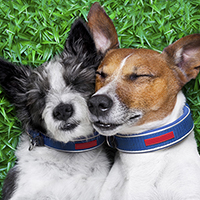Separation anxiety is the kind of sensation that we can relate to. Young children have the same sort of anxiety when their parents leave for a night out. They learn that their parents will return and do not feel anxiety anymore. The same process has to happen for our dogs so that their anxiety is reduced. Anxiety in dogs will often manifest as disconsolate howling, chewing things or uncontrolled urination. If the dogs stays indoors this can be a problem for you. This article will give you some ideas on how to ease separation anxiety in dogs.
Separation anxiety prevention should begin at birth. A puppy that is not allowed to wean off it's mother could display separation anxiety in later life. It should be weaned off and relatively independent by around the eight week period so don't get a puppy that is younger than this.
Separation anxiety training can begin as soon as the puppy enters your home (it's new home). It is hard to resist a new puppy but you should not make a big fuss of it too much. This is especially the case when you are leaving it at night time. Place it in the sleeping basket and walk away. This will get it used to you leaving and being alone for extended periods.
Try to communicate the fact that you will not always be there and your dog should not suffer form separation anxiety when it gets older.
Training a puppy is relatively straightforward, however it may not be as easy with a grown dog that is suffering from this problem. The dog may have been given to you by a previous owner or you found him at the dog shelter.
If it has come from the pound or shelter then it may have been neglected in the past. Dog's a sensitive to abandonment and have a rational fear of being separated from the owner. It may have received little affection whilst in the pound too, which will only heighten it's anxiety.
If a dog has been given away by a previous owner there is generally a good reason for this. The dog may have behavioral problems but it may also be that the family has had it own share of problems. The couple may be going through a divorce or maybe they are having financial difficulties. All these problems will filter through to the dog and could manifest as separation anxiety.
The way to train a grown dog for separation anxiety is to take the softly softly approach. Practice leaving your pet. Start off with just a short separation, say a minute or so. Close the door to indicate that you have left. Wait a minute and then come back in. Don't make a fuss of the dog when you leave or come back.
Continue this mock separation process but increase the time each time you separate. If you hear the dog getting anxious then return to a separation interval that he is comfortable with. Gradually the dog will be completely adjusted to separation and will not get anxious.
Other strategies that may work are to keep you pet bust while you are out. So you could hide some tasty treats in the garden to take his mind off the fact that he is alone.

 CHF and Zoetis Podcast Reproduction Series Brucellosis
The AKC Canine Health Foundation (C
CHF and Zoetis Podcast Reproduction Series Brucellosis
The AKC Canine Health Foundation (C
 Is Pet Insurance Right for Your Puppy?
Is Pet Insurance Right for Your Puppy?
Is Pet Insurance Right for Your Puppy?
Is Pet Insurance Right for Your Puppy?
 Signs of a Dog That Has Lost Her Litter of Puppies
Signs of a Dog That Has Lost Her Litter of Pup
Signs of a Dog That Has Lost Her Litter of Puppies
Signs of a Dog That Has Lost Her Litter of Pup
 Let’s Go to the Vet
Let’s Go to the Vet – M
Let’s Go to the Vet
Let’s Go to the Vet – M
 What Questions Should Dog Owners Ask Their Vet?
What Questions Should Dog Owners Ask Their Ve
What Questions Should Dog Owners Ask Their Vet?
What Questions Should Dog Owners Ask Their Ve